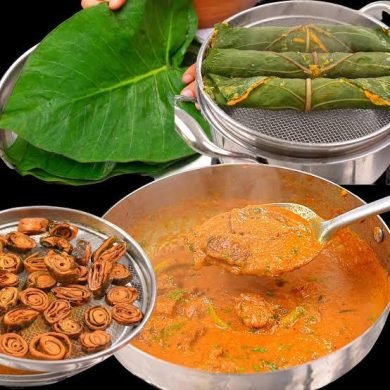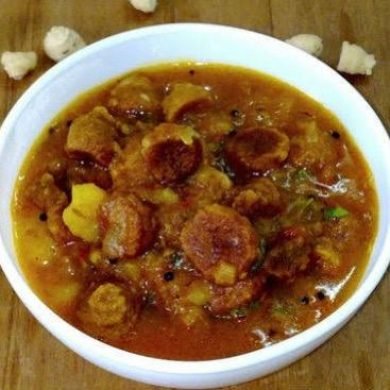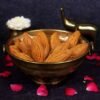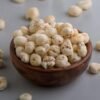Gobhi Sukhauti (Dried Cauliflower): A Detailed Exploration of a Timeless Indian Recipe

Indian cuisine is renowned for its diversity, rich flavors, and the innovative use of various ingredients, many of which are staples in every household. Among the myriad of dishes to explore, Gobhi Sukhauti stands out as a humble yet flavorful recipe that celebrates the essence of cauliflower, a vegetable that holds a special place in Indian kitchens. While fresh cauliflower is commonly used in many dishes, dried cauliflower offers a unique texture and flavor profile that can be leveraged to create a dish that’s both delicious and convenient. In this blog, we will delve into the details of making Gobhi Sukhauti with dried cauliflower, a recipe that promises to be a delightful addition to your culinary repertoire.
The Origins and Versatility of Cauliflower in Indian Cuisine
auliflower, known as “gobhi” in Hindi, has been an integral part of Indian cuisine for centuries. Introduced to India during the colonial period, cauliflower quickly became a popular vegetable due to its adaptability to the Indian climate and soil. Over time, it has been incorporated into a wide range of dishes, from curries and stir-fries to pickles and pakoras.
The use of dried vegetables, including cauliflower, is a common practice in many parts of India, particularly in regions where fresh vegetables may not always be available year-round. Drying vegetables is a traditional method of preservation that not only extends their shelf life but also intensifies their flavors. Dried cauliflower, or “sukhi gobhi,” is one such preserved vegetable that is often stored in kitchens across India, ready to be used in various dishes.
One of the most appealing aspects of using dried cauliflower is its convenience. Unlike fresh cauliflower, which needs to be cleaned, chopped, and cooked immediately, dried cauliflower can be stored for long periods and rehydrated whenever needed. This makes it an excellent option for quick meals or when fresh vegetables are not readily available.
Gobhi Sukhauti with Dried Cauliflower: A Detailed Exploration of a Timeless Indian Recipe
~ R k shah
The Art of Making Gobhi Sukhauti
obhi Sukhauti is a dry preparation, meaning the cauliflower is cooked without much liquid, allowing it to fully absorb the flavors of the spices. The dish is characterized by its simplicity and the balance of spices that enhance the natural taste of the cauliflower. While the recipe may seem straightforward, the key lies in the technique and the sequence in which the ingredients are added.
Let’s explore the recipe in detail:
Ingredients:
- 100 grams of dried cauliflower: The star of the dish, dried cauliflower is rehydrated before cooking to regain its texture and absorb the flavors of the spices.
- 2 tablespoons of oil: Oil serves as the cooking medium, helping to sauté the spices and onions while also adding richness to the dish.
- ½ teaspoon cumin seeds: Cumin seeds, or “jeera,” are a common spice in Indian cooking. They are typically added to hot oil at the beginning of the cooking process to release their aroma and flavor.
- 1 pinch asafoetida powder: Asafoetida, or “hing,” is a strong-smelling spice that adds a unique umami flavor to the dish. A little goes a long way, so it’s important to use it sparingly.
- 2 medium onions, finely chopped: Onions form the base of the dish, providing sweetness and depth of flavor.
- ½ teaspoon ginger paste: Ginger adds a fresh, spicy note that complements the other spices.
- ½ teaspoon garlic paste: Garlic, with its pungent flavor, enhances the overall taste of the dish.
- 1-2 teaspoons chili powder: The amount of chili powder can be adjusted according to your preference for heat. It adds a fiery kick to the dish.
- 1 teaspoon turmeric powder: Turmeric, or “haldi,” is a staple in Indian cooking. It adds a warm, earthy flavor and a beautiful golden color to the dish.
- 2 tomatoes, finely chopped: Tomatoes add acidity and sweetness, balancing the spices and creating a rich base for the dish.
- 1 teaspoon salt (or to taste): Salt is essential for bringing out the flavors of the other ingredients.
- ¼ cup chopped coriander leaves: Fresh coriander, or “dhaniya,” is used as a garnish, adding a burst of freshness to the dish.
- ¼ teaspoon garam masala: Garam masala is a blend of ground spices commonly used in Indian cooking. It’s added towards the end of the cooking process to enhance the flavor and aroma of the dish.
Instructions:
Preparing the Dried Cauliflower:
- Begin by soaking 100 grams of dried cauliflower in warm water for about 20-30 minutes. This step is crucial as it rehydrates the cauliflower, restoring its texture and making it ready to absorb the flavors of the spices.
- Once the cauliflower has softened, drain the water and set the cauliflower aside. Ensure that the cauliflower is thoroughly drained to prevent any excess water from diluting the spices.
Cooking the Spices:
- Heat 2 tablespoons of oil in a heavy-bottomed pan over medium heat. The type of oil you use can influence the flavor of the dish. While vegetable oil is commonly used, you can opt for mustard oil for a more traditional taste or olive oil for a lighter version.
- Once the oil is hot, add ½ teaspoon of cumin seeds. Allow them to sizzle and turn slightly brown, which releases their aromatic flavor into the oil. Cumin seeds are often the first spice added to the oil in Indian cooking, as they infuse the oil with their earthy, nutty flavor.
- Add a pinch of asafoetida powder. Asafoetida is a strong spice with a pungent smell that mellows out when cooked, leaving behind a savory, umami flavor that enhances the overall taste of the dish. Be careful not to use too much, as its flavor can easily overpower the other ingredients.
Adding Asafoetida and Onions:
- Immediately after the asafoetida, add the chopped onions. Sauté the onions until they turn golden brown. This process may take a few minutes, but it’s important not to rush it, as the caramelization of the onions is key to developing the depth of flavor in the dish.
- The onions provide a sweet base that balances the heat of the chili powder and the sharpness of the ginger and garlic. Their caramelized flavor adds a layer of complexity to the dish.
Incorporating Ginger and Garlic:
- Once the onions have reached the desired golden brown color, add ½ teaspoon each of ginger paste and garlic paste. These two ingredients are staples in Indian cooking, known for their ability to add warmth and depth to any dish.
- Sauté the ginger and garlic for about a minute, or until the raw smell disappears. This step ensures that the ginger and garlic blend seamlessly with the onions, creating a harmonious base for the dish.
Spicing it Up:
- Now it’s time to add the spices. Start with the chili powder, adjusting the quantity based on your heat preference. The chili powder adds a spicy kick that makes the dish exciting and flavorful.
- Follow with 1 teaspoon of turmeric powder. Turmeric is not only valued for its flavor but also for its health benefits. It’s known for its anti-inflammatory properties and is often used in Indian cooking for both its taste and its golden color.
- Stir the spices well to combine them with the onions, ginger, and garlic. This step is crucial as it allows the spices to cook slightly, enhancing their flavors and ensuring they are evenly distributed throughout the dish.
Cooking the Tomatoes:
- Add the chopped tomatoes to the pan. Tomatoes are a vital ingredient in many Indian dishes, as they add acidity and sweetness, which help to balance the spices.
- Cook the tomatoes until they soften and release their juices. This process creates a rich, flavorful base that the cauliflower will absorb. The tomatoes also contribute to the overall texture of the dish, making it moist without being too wet.
Adding the Dried Cauliflower:
- Now, add the soaked cauliflower to the pan. Stir well to ensure the cauliflower is thoroughly coated with the spice mixture.
- Cook on medium heat, stirring occasionally, until the cauliflower is tender and infused with the flavors of the spices. This process should take about 10-12 minutes. The cauliflower should be cooked through but still retain some bite, giving the dish a satisfying texture.
- As the cauliflower cooks, it will absorb the flavors of the spices, onions, and tomatoes, creating a dish that is both flavorful and aromatic.
Final Touches:
- Once the cauliflower is cooked, season the dish with salt to taste. Salt is essential in bringing out the flavors of the other ingredients, so be sure to adjust it according to your preference.
- Stir in the chopped coriander leaves. Fresh coriander adds a burst of freshness that contrasts beautifully with the rich, spiced cauliflower.
- Finally, sprinkle ¼ teaspoon of garam masala over the dish. Garam masala is a blend of spices that adds warmth and complexity to the dish. It’s usually added towards the end of the cooking process to preserve its delicate flavors.
Serving:
- Your Gobhi Sukhauti is now ready to be served! This dish pairs wonderfully with roti, paratha, or as a side with rice. It can also be enjoyed on its own as a light meal.
- Garnish the dish with additional coriander leaves if desired, and serve hot.
Exploring the Nutritional Benefits of Gobhi Sukhauti
In addition to its delicious taste, Gobhi Sukhauti is also a nutritious dish. Cauliflower is a low-calorie vegetable that is rich in vitamins and minerals, including vitamin C, vitamin K,










Add comment
You must be logged in to post a comment.